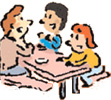|
|
Clean AirBackground - Air Quality at School |
Clean air, inside and outside, makes for better health. Earth can support life because of its protective but fragile atmosphere: a mixture of gasses and particles that surround the planet. Human activities are affecting our atmosphere making it less able to protect us. Air pollution is one such problem. It is broadly defined as the presence in the air of any substance that can affect people's health or the health of plants and animals, or that causes damage to property and to our environment. These substances are in large part emitted by human activities, but they can also come from natural processes. They are at the source of environmental issues such as smog and acid rain and some of the substances can affect the ozone layer and contribute to climate change.
Little things make a big difference. We can help to reduce and prevent air pollution by using less electricity and gasoline. It may seem as if the emissions from one vehicle are not enough to pollute the air. Still, put together with the emissions of the many millions of other vehicles in Canada, there is a definite impact on the environment. If each of us left our car at home just once a week, the reduction in emissions would be substantial and help to improve our air quality.
Vehicle idling in the parking lot is a problem. Even on cold days, 30 seconds is all you need to warm up a car. School bus idling exposes children to unnecessary diesel exhaust. We know that inhaling the fumes outside the bus is dangerous to our health, but it has also been found that exhaust levels inside the school bus are actually higher, especially at the back of the bus.
Every choice we make to limit emissions that cause air pollution, whether small lifestyle changes like walking short distances rather than driving or major decisions, is a choice for cleaner air.
|
Where can air pollution occur at school? |
 |
Art and Science Classrooms: fumes from art supplies and chemical experiments
Parking Lot: exhaust from idling school buses, cars
School Grounds: lawn mowers, snow blowers
Entire School: heating and ventilation systems, lights and other electrical items
 |
|
Do your bit for clean air so everyone can breathe easy at school.
Some ideas for taking action:
·Walk, cycle or use public transportation whenever possible.
·Turn off lights, computer equipment and other electrical items when not in use, and especially at the end of the day.
·Make your school a "no idling zone". Post "No Idling" signs in parking areas to remind motorists to turn off their engines. It is important to note that signs alone are not be enough to see a significant change in idling. Produce an information pamphlet for distribution to explaining the benefits of not idling.
·Car pool as much as possible by giving friends who are going to the same place as you a ride.
·In winter, idling is sometimes unavoidable, but parents can reduce their idling time by reducing their arrival time at school.
·Use cleaner fuels in your car. Take care not to overfill the gas tank. Spills could enter the sewer and eventually enter our lakes.
·Keep your car tuned and schedule routine maintenance checks. Keep tires properly inflated and avoid carrying extra weight in your vehicle.
·At home, use a timer to switch on your block heater one to two hours before you plan to drive. A warm engine means easier starting, fewer emissions, and less need for idling.
·Avoid using a remote car starter. It encourages you to start your car before you are ready to drive, which means unnecessary idling.
Helpful Air Pollution and Indoor Air Quality Web Sites
The following Web sites have interesting information on air pollution and air quality as well as information directly relating to air quality in schools.
http://www.hc-sc.gc.ca/hecs-sesc/air_quality/publications/tools_school/toc.htm
Health Canada’s Tools for Schools – Indoor Air Quality Action Kit for Canadian Schools was developed in collaboration with the Indoor Air Quality Working Group of the Federal-Provincial-Territorial Committee on Environmental and Occupational Health (CEOH). This kit provides a process and the tools to help schools prevent, identify, assess, and address the majority of indoor air problems with minimal cost and involvement.
Environment Canada’s clean air site includes information on air pollution, smog, acid rain, ground-level ozone, mercury, particulate matter and persistent organic pollutants (POPs). Links to other clean air-related web sites.
www.healthyschools.org/kids.html
Founded in 1995, Healthy Schools Network, Inc. (HSN) is a United States, not for profit organization centered on children's environmental health and dedicated to assuring an environmentally safe and healthy school.
|
Ideas for Great Acts |
 |
Make a difference when it comes to air quality with Great Acts such as this:
Launch an anti-idling awareness campaign at school to stop unnecessary engine idling and improve air quality at your school and in your community. http://www.oee.nrcan.gc.ca/communities-government/transportation
 |
Games and Activities |
Get all the facts on acid rain, what’s being done and what’s new. The Kids Corner features experiments and projects for Grades K-4, Grades 5-8 and Grades 9-12, as well as information and resources.
SchoolNet links to many of the Internet's most engaging and informative sites selected to meet the needs of students, teachers and parents.
www.ec.gc.ca/ozone/EN/kidzone/index.cfm
Accessible, readable and fun information about the ozone layer and what we can do to protect it. Includes an ozone layer quiz.
 |
Students Leading the Way – Tell us what actions you're taking to stop air pollution and keep our air clean. |
 |





